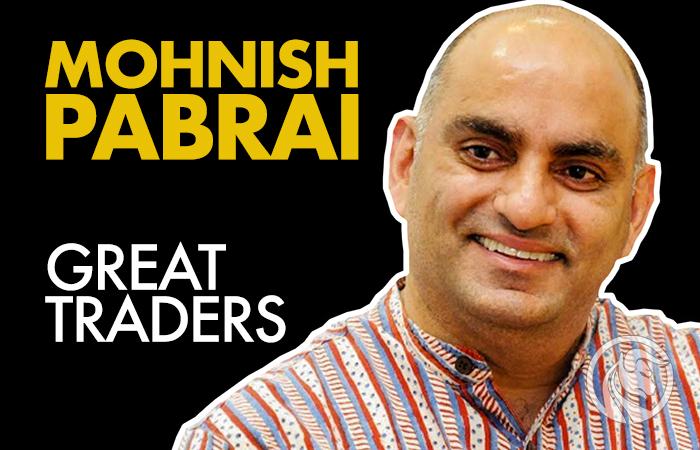Mohnish Pabrai - who is the Indian "Warren Buffett"?
Most of the best-known investors are from the United States or Europe. However, a brilliant investor can be born in any country. In order to show his skills, he needs only the right conditions for development. One perfect example is Mohnish Pabrai, who is called by some "Buffett of India". It became louder about this outstanding investor after the situation in 2007. Back then, Mohnish paid $ 650 for lunch with Warren Buffett. The amount paid was donated to charity.
Who is Mohnish Pabrai
After the sale of the company, Monish began investing in the capital market. He created an investment structure based on the solution used by Buffett in the XNUMXs (Buffet Partnership). Pabrai has invested one million dollars in the capital market. By investing from fundamental analysis, this Indian investor has achieved a spectacular rate of return. His secret was also to accept his weaknesses. At the beginning, he was of the opinion that he would not gain an advantage in the segment of the largest enterprises. He was of the opinion that blue chip companies were constantly analyzed by specialists. As a result, the intrinsic value of these enterprises not very often differed significantly from market prices. However, in the case of small and medium-sized enterprises, the number of professionals 'covering' them is small. This is because the capitalization of these companies is too small to invest significant capital in them (from the perspective of funds managing billions of dollars). His success was stunning. During twenty years of investment, his fund generated a profit exceeding 1000%. Currently, Pabraia funds have assets in excess of hundreds of millions of dollars.
Investment philosophy
Mohnish Pabrai invests on the basis of fundamental analysis. His favorite investments were companies that he bought for a fraction of their true value. He liked the situations they contained "High uncertainty and low risk". He believed that it was difficult for people to distinguish uncertainty from risk. Sometimes negative information, such as weaker quarterly results or a worse forecast of results, caused a sharp sell-off of the company. Due to market pessimism, the situation arose that a company that was "under normal" worth $ 1 billion was valued at just $ 300 million. At the same time, the risk of losing funds on this investment was insignificant due to the profits generated by the company or its assets. The investment strategy was therefore very similar to that followed by "Early" Buffett and by Benjamin Graham. She was also important to Pabrai "Safety margin". It was the difference between the intrinsic value of the enterprise and its market valuation. The higher it was, the lower the investment risk was.
Short sale opinion
Mohnish Pabrai he is also not an advocate of playing on the company's decline. He proved this in 2003 when he published an article on TheStreet.com: "Steer Clear of the Short Side". For Pabrai, the return on risk is not very favorable. In theory, a non-leveraged position can generate a profit of 100%. This will happen when the price of the stock whose short selling trader starts drops to 0. In case of a mistake, the short-selling trader may lose a multiple of the potential profit. According to Pabrai, the mere reevaluation of the stock is not a reason to act shortly. Sometimes the market can be irrational longer than a solvent investor.
Entrepreneur and investor
Pabrai also has a peculiar view of the difference between portfolio managers and company managers. He compared them to the work of an astronomer and astronaut. The words seem similar, but the astronomer studies the cosmos "from a distance" by taking measurements and analyzing celestial bodies thousands of years away. In turn, the astronaut has contact with the cosmos "directly". It is he who experiences the state of weightlessness and walks around the space station. Both professions need different types of people. The same is true of the fund manager and the president of the company. The fund manager looks at the market "from a distance". He analyzes the available information and tries to build a forecast model that can reach up to 10 years ahead. Such a person may be introverted, but must have a very analytical mind.
In turn, the company's president focuses on outlining and implementing the strategy. Such people must be go-getting and have highly developed interpersonal skills. They don't have to be analytical. Very often, CEOs look at companies in a completely different way than managers, which causes mutual misunderstanding. According to him, investors who are entrepreneurs themselves have a big advantage. Thanks to this, they can look at problems "from both sides of the barricade". He gave as an example Warren Buffett, who became a better investor by being a businessman, and became a better entrepreneur by being an investor.
Investing in market stars
It is worth explaining why Pabrai did not like investing in the largest publicly traded companies. He expressed it in the article "The Danger in Buying the Biggest" from 2002. As an example, he mentioned a hypothetical investment in the largest companies listed in the USA. If the investor in April 1987 invested all the money in the largest company on the stock exchange (IBM) and at the beginning of each year reinvested the money in the largest company on the market. By 2002, it would have achieved an average annual rate of return of 3,3%. At the same time S&P 500 index generated an average annual rate of return of 10%. At the time, Pabrai was of the opinion that the larger the company, the more difficult it was to find competent managers who can manage an ever larger corporation. Management inefficiencies appear, which reduce the return on capital.
diversification
Another element of the investment strategy was a slight diversification of the investment portfolio. This was due to the fact that for Pabraia, diversifying the portfolio "by force" so that it had a "book" number of companies was a consent to the deterioration of the quality of the investment portfolio. According to Mohnish, there is nothing wrong with having just a few companies in the portfolio. The only condition is to invest in companies with a high safety margin. He himself often managed to have only 3-5 companies in the portfolio.
Mohnish Pabrai and his cinvestment hecklist
Before investing in any company, Pabrai prepared the so-called checklist. It was an answer to standard questions that are supposed to reduce the risk of making an investment mistake. The investment should also be well thought out. For this reason, before any purchase of stocks, an investor should answer the following questions:
- Is the company's business understandable to me and is it within my area of competence?
An investor should only invest his funds in companies that are understandable. Otherwise, there may be a problem with the proper valuation of the company. Even Warren Buffett had given up many of his investments due to the difficulty of understanding how the company made money and what its advantages were. This did not prevent Warren from becoming one of the best investors in the world.
- Do I know what the intrinsic value of the company is today and how it may change in the coming years?
The investor should estimate the intrinsic value of the company. He should assume a neutral or pessimistic scenario to minimize the risk of overpaying for the enterprise. The investor should also estimate how goodwill may change in the future. Some firms will increase their intrinsic value (increase profits and free cash flow), while others will be worth less and less (firms in shrinking industries).
- Is the current market price much lower than the intrinsic value of the company now and in the next 2-3 years?
Then the investor should compare the current market valuation with the calculated theoretical value of the company. Pabrai prefers a situation where the intrinsic value is several times greater than the current capitalization. This gives a high safety margin.
- Would I like to invest a large proportion of my net worth in this company?
Mohnish believes that an investor should be comfortable with the position. If he has any objections, he should abandon the investment idea. The check is the answer to the question below. If an investor would not mind investing 1/3 of his net worth in a given company, it means that he has no significant objections to the investment.
- What is the potential downside?
Downside is the company's valuation in the case of the implementation of negative scenarios. It could be a loss of market share or a decline in profitability. The lower the potential downside, the greater the investment risk.
- Does the company have a moat to protect it from competition?
The moat is one of the most important weapons in the arsenal of any enterprise. It is thanks to her that the company can protect or even increase your market share. A moat can be patents, brand, long-term contracts with customers or company culture. This part of the analysis is qualitative and not quantitative. For this reason, it makes sense to be honest about the moat assessment and not to deceive yourself.
- Is the company's management honest and competent?
Even the great potential of the company can be wasted by dishonest and incompetent management. Therefore, the investor should carefully examine the stories of the most important people in the management board and look at who is in the shareholding of the company.






















![Forex Club – Tax 9 – Settle tax on a foreign broker [Download the Application] Forex Club - Tax 9](https://forexclub.pl/wp-content/uploads/2024/02/Forex-Club-Podatek-9-184x120.jpg?v=1709046278)
![Trading View platform – solutions tailored to the needs of traders [Review] trading view review](https://forexclub.pl/wp-content/uploads/2024/03/trading-view-recenzja-184x120.jpg?v=1709558918)
![How to connect your FP Markets account to the Trading View platform [Guide] fp markets trading view](https://forexclub.pl/wp-content/uploads/2024/02/fp-markets-trading-view-184x120.jpg?v=1708677291)
![How to invest in ChatGPT and AI? Stocks and ETFs [Guide] how to invest in chatgpt and artificial intelligence](https://forexclub.pl/wp-content/uploads/2023/02/jak-inwestowac-w-chatgpt-i-sztuczna-inteligencje-184x120.jpg?v=1676364263)




![Izabela Górecka – “Success on the market depends not only on knowledge, but also on emotional stability” [Interview] Izabela Górecka - interview](https://forexclub.pl/wp-content/uploads/2024/04/Izabela-Gorecka-wywiad-184x120.jpg?v=1713870578)
![WeWork – the anatomy of the collapse of a company valued at $47 billion [WeWork, part II] wework bankruptcy story](https://forexclub.pl/wp-content/uploads/2024/04/wework-bankructwo-historia-184x120.jpg?v=1711729561)
![Adam Neumann – the man who screwed up Softbank [WeWork, part AND] adam neumann wework](https://forexclub.pl/wp-content/uploads/2024/04/adam-neumann-wework-184x120.jpg?v=1711728724)




![The most common mistakes of a beginner trader - Mr Yogi [VIDEO] Scalping - The most common mistakes of a beginner trader - VIDEO](https://forexclub.pl/wp-content/uploads/2024/03/Scalping-Najczestsze-bledy-poczatkujacego-tradera-VIDEO-184x120.jpg?v=1711601376)
![Learning patience: No position is also a position - Mr Yogi [VIDEO] Scalping - Learning patience - No position is also a position - VIDEO](https://forexclub.pl/wp-content/uploads/2024/03/Scalping-Nauka-cierpliwosci-Brak-pozycji-to-tez-pozycja-VIDEO-184x120.jpg?v=1710999249)
![When to exit a position and how to minimize losses - Mr Yogi [VIDEO] Scalping - When to exit a position and how to minimize losses - VIDEO](https://forexclub.pl/wp-content/uploads/2024/03/Scalping-Kiedy-wyjsc-z-pozycji-i-jak-minimalizowac-straty-VIDEO-184x120.jpg?v=1710336731)




![Izabela Górecka – “Success on the market depends not only on knowledge, but also on emotional stability” [Interview] Izabela Górecka - interview](https://forexclub.pl/wp-content/uploads/2024/04/Izabela-Gorecka-wywiad-300x200.jpg?v=1713870578)
![Trading View platform – solutions tailored to the needs of traders [Review] trading view review](https://forexclub.pl/wp-content/uploads/2024/03/trading-view-recenzja-300x200.jpg?v=1709558918)













Leave a Response